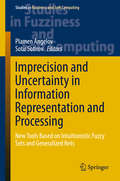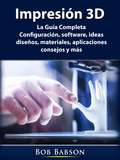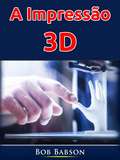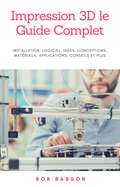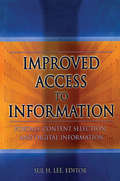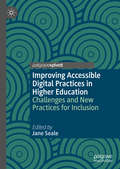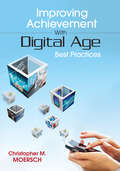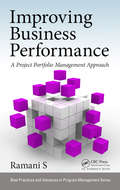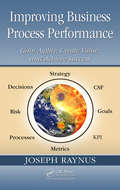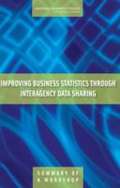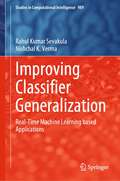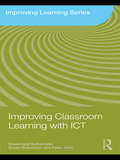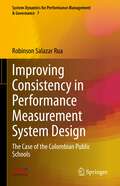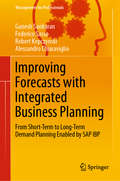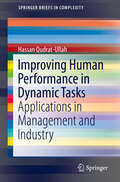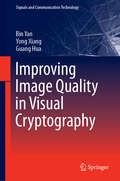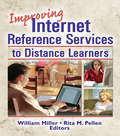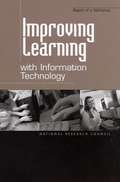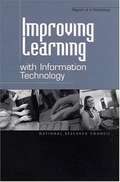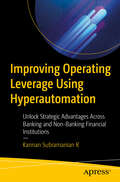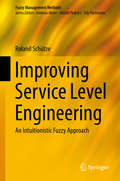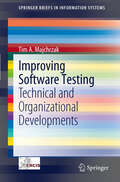- Table View
- List View
Imprecision and Uncertainty in Information Representation and Processing
by Sotir Sotirov Plamen AngelovThe book offers a comprehensive and timely overview of advanced mathematical tools for both uncertainty analysis and modeling of parallel processes, with a special emphasis on intuitionistic fuzzy sets and generalized nets. The different chapters, written by active researchers in their respective areas, are structured to provide a coherent picture of this interdisciplinary yet still evolving field of science. They describe key tools and give practical insights into and research perspectives on the use of Atanassov's intuitionistic fuzzy sets and logic, and generalized nets for describing and dealing with uncertainty in different areas of science, technology and business, in a single, to date unique book. Here, readers find theoretical chapters, dealing with intuitionistic fuzzy operators, membership functions and algorithms, among other topics, as well as application-oriented chapters, reporting on the implementation of methods and relevant case studies in management science, the IT industry, medicine and/or education. With this book, the editors wish to pay homage to Professor Krassimir Todorov Atanassov for his pioneering work on both generalized nets and intuitionistic fuzzy set.
Impresión 3D: La Guía Completa: Configuración, software, ideas, diseños, materiales, aplicaciones, consejos y más
by Bob BabsonImpresión 3D La Guía Completa: Configuración, software, ideas, diseños, materiales, aplicaciones, consejos y más por Bob Babson En este libro aprenderá todo sobre la impresión en 3D y cómo empezar. Impresión 3D de la guía completa: configuración, software, ideas, diseños, materiales, aplicaciones, consejos y más ¿Le gustaría comprar una impresora 3D pero no tiene ni idea de cuál comprar? ¿Le gustaría aprender a utilizar las impresoras 3D para imprimir objetos y diseños sorprendentes? En este libro aprenderá todo sobre la impresión en 3D y cómo empezar. Aprende: -Cómo empezar -Qué impresoras 3D comprar -Características y capacidades de las impresoras 3D + MUCHO MÁS! Descargo de responsabilidad: Este autor y/o propietario(s) de derechos no hace reclamos, promesas o garantías sobre la exactitud, integridad o adecuación de los contenidos de este libro, y expresamente niega responsabilidad por errores y omisiones en los contenidos dentro de este libro. Este producto es sólo para uso de referencia.
A Impressão 3D
by Bob BabsonGostaria de comprar uma impressora 3D mas não tem ideia de qual comprar? Gostaria de aprender como começar com as impressoras 3D, com o objetivo de imprimir objetos e designs incríveis? Nesse livro você irá aprender tudo sobre a impressão 3D e como começar. Aprenda: -Como começar -Qual impressora 3D comprar -Características e capacidade das impressoras 3D + MUITO MAIS!
Impression 3D le Guide Complet: Installation, logiciel, idées, conceptions, matériaux, applications, conseils et plus
by Bob BabsonDans ce livre, vous apprendrez tout sur l'impression 3D et son fonctionnement. Impression 3D, le guide complet : Installation, logiciel, idées, conceptions, matériaux, applications, conseils et plus Vous souhaitez acheter une imprimante 3D mais vous ne savez pas laquelle ? Vous voulez apprendre à utiliser des imprimantes 3D pour imprimer des objets et des dessins époustoufflants ? Dans ce livre, vous apprendrez tout sur l'impression 3D et la bonne méthode pour commencer. Découvrez : -Comment débuter -Quelles imprimantes 3D acheter -Les caractéristiques et capacités des imprimantes 3D + BIEN PLUS ENCORE ! Avis de non-responsabilité : L'auteur et/ou le(s) propriétaire(s) des droits ne font aucune réclamation, promesse ou garantie quant à l'exactitude, l'exhaustivité ou la pertinence du contenu de cet ouvrage, et déclinent expressément toute responsabilité pour les erreurs et omissions dans le contenu de ce dernier. Ce produit est uniquement destiné à être utilisé à titre de référence.
Improved Access to Information: Portals, Content Selection, and Digital Information
by Sul H LeeConnect patrons with the information they seek with these promising electronic tools! Improved Access to Information: Portals, Content Selection, and Digital Information focuses on how you can improve access to information using electronic reference resources. This book features nine of America&’s leading library administrators who give their perspectives, observations, and stipulations on how to meet the research needs of patrons in a digital age. This timely resource is relevant to senior library administrators in the process of developing electronic tools and services. Improved Access to Information addresses the current library issue of how to utilize scarce resources to provide an ever-increasing amount of electronic information to an ever-expanding user base. The use of portals and their advantages are discussed in detail and from the different perspectives of information providers and users. Several authors offer instructive graphs, tables, and other illustrations to emphasize their findings. In Improved Access to Information, you&’ll learn more about: the variety of groups that libraries serve cooperative collection development the balance of print and electronic resources the evolvement of collection development in libraries to the concept of knowledge development the implementation of portals in research libraries the factors influencing the selection of electronic resources digitizing unique collections for preservation and improved access The product of the 2003 University of Oklahoma Libraries annual conference, Improved Access to Information offers library administrators new approaches for overcoming the proliferation of electronic information and making it readily available to users. This book will help you provide essential research services to your users and secure your patron base.
Improving Accessible Digital Practices in Higher Education: Challenges and New Practices for Inclusion
by Jane SealeThis book examines the role played by technologies in removing the disadvantage experienced by students with disabilities in higher education. Addressing five key themes, the editor and contributors explore the practices required of stakeholders within higher education institutions to mediate successful and supportive relationships between disabled learners and their technologies. Ultimately, the book argues that practice in the fields of disability, ICT and higher education is still not providing consistent and widespread positive learning experiences to students with disabilities. In order to address this situation, the field needs to creatively integrate knowledge gained through both research and practice, and to re-imagine what is needed for ICT to meaningfully contribute to a reduction in disadvantage for disabled students. This book will be of interest and value to scholars of disability studies, education and accessibility, and educational technologies.
Improving Achievement With Digital Age Best Practices
by Christopher M. MoerschConnect Common Core, inquiry, and technology! While technology ushers in exciting and innovative educational opportunities, finding best practices for complete integration remains a challenge. In this practical resource, educators will discover a roadmap for implementing digital age best practices. With discussions on how to promote networked collaboration, bolster purposeful inquiry, and anchor student decision-making and learning with digital-age tools, these research-based strategies deliver: A user-friendly road map for digital transition into new Common Core Standards Lesson plans, benchmarks, and instructional units to bridge the link between 21st century skills, Common Core Standards, and student achievement Practical tips for classroom, building, and district implementation Tools and guidance for successful PLCs
Improving Business Performance: A Project Portfolio Management Approach (Best Practices in Portfolio, Program, and Project Management)
by Ramani SNo organization is impervious to change. Rather, the survival and growth of an organization is dependent on how well it copes with change. Successful change initiatives consist of the integrated eco-system of its portfolio, programs, and projects. These change initiatives become the delivery mechanisms for implementing the strategy of an organization.Improving Business Performance: A Project Portfolio Management Approach clarifies how the proper application of portfolio, program, and project management concepts can help commercial and non-profit organizations achieve their strategic objectives. Most organizations have been good at devising strategy, but falter during its implementation. Executing strategy well to deliver superior business performance remains a key challenge, which is addressed as the core theme of this book.The book portrays a top-down orientation as well as a bottom-up integration of change initiatives to facilitate alignment to strategy and accommodate mid-course changes. It takes into account existing global best management practices to bring forth an approach that is customizable and useful to organizations in any industry.Describing why portfolio management lies at the apex of change initiative management, the book explains how to design and fine-tune portfolios so they are in alignment with your organization’s overall strategy and business needs. After reading this book, you will understand: How to design the project portfolio structure for your organization How to integrate programs and projects within the portfolio more effectively How to better manage interactions across diverse change initiatives How to maintain focus while managing change to realize benefits The book presents a case study that illustrates the application of project portfolio concepts in practical scenarios. It includes chapters dedicated to transition management, change management, benefits management, and the Enterprise Project Management Office. It also includes templates you can immediately put to use in your own portfolios, programs, and projects.
Improving Business Process Performance: Gain Agility, Create Value, and Achieve Success
by Joseph RaynusThe managerial practices that successfully drove industry for decades have become insufficient to support the rapidly changing business landscape. Companies around the world are being challenged to improve performance, reshape operations, and adapt swiftly to new opportunities. With an abundance of improvement methodologies and frame
Improving Business Statistics Through Interagency Data Sharing: Summary Of A Workshop
by National Research Council of the National AcademiesThe National Academies Press (NAP)--publisher for the National Academies--publishes more than 200 books a year offering the most authoritative views, definitive information, and groundbreaking recommendations on a wide range of topics in science, engineering, and health. Our books are unique in that they are authored by the nation'#8217;s leading experts in every scientific field.
Improving Classifier Generalization: Real-Time Machine Learning based Applications (Studies in Computational Intelligence #989)
by Rahul Kumar Sevakula Nishchal K. VermaThis book elaborately discusses techniques commonly used to improve generalization performance in classification approaches. The contents highlight methods to improve classification performance in numerous case studies: ranging from datasets of UCI repository to predictive maintenance problems and cancer classification problems. The book specifically provides a detailed tutorial on how to approach time-series classification problems and discusses two real time case studies on condition monitoring. In addition to describing the various aspects a data scientist must consider before finalizing their approach to a classification problem and reviewing the state of the art for improving classification generalization performance, it also discusses in detail the authors own contributions to the field, including MVPC - a classifier with very low VC dimension, a graphical indices based framework for reliable predictive maintenance and a novel general-purpose membership functions for Fuzzy Support Vector Machine which provides state of the art performance with noisy datasets, and a novel scheme to introduce deep learning in Fuzzy Rule based classifiers (FRCs). This volume will serve as a useful reference for researchers and students working on machine learning, health monitoring, predictive maintenance, time-series analysis, gene-expression data classification.
Improving Classroom Learning with ICT (Improving Learning)
by Rosamund Sutherland Susan Robertson Peter JohnImproving Classroom Learning with ICT examines the ways in which ICT can be used in the classroom to enhance teaching and learning in different settings and across different subjects. Weaving together evidence of teachers’ and learners’ experiences of ICT, the authors: explain why the process of integrating ICT is not straightforward; discuss whether hardware and infrastructure alone are sufficient to ensure full integration and exploitation of ICT investment; emphasise the pivotal role that teachers play in supporting learning with ICT across the curriculum; argue that teachers need a greater understanding of how to put ICT to use in teaching and learning; highlight that out-of-school use of ICT has an impact on in-school learning; consider what kinds of professional development are most effective in supporting teachers to use technologies creatively and productively. Case studies are used to illustrate key issues and to elaborate a range of theoretical ideas that can be used in the classroom. This book will be of interest to all those concerned with maximising the benefits of ICT in the classroom.
Improving Consistency in Performance Measurement System Design: The Case of the Colombian Public Schools (System Dynamics for Performance Management & Governance #7)
by Robinson Salazar RuaThis book analyzes behavioral distortions in public schools and delineates outcome-based performance measurement systems that can prevent and mitigate them. An instrumental view of dynamic performance management (DPM) is used to support the endeavor by identifying how performance drivers affect end results of outcome and output, how end results affect strategic resources, and how strategic resources and benchmarks define the dynamics of performance drivers. This approach is also used to promote a shift from an output-oriented to an outcome-oriented view in performance management, with the aim of achieving sustainable results in the long term. The book also includes a comprehensive literature review at the end of each chapter, intended to strengthen readers’ knowledge and encourage further research. Given its scope, the book will appeal to graduate students in public management, researchers in performance management, system dynamics, and education, and decision-makers in public schools.
Improving Decision Making Using Semantic Web Technologies
by Tek Raj ChhetriAs technology becomes integral to our lives, its influence on decision making in smart cities, healthcare, and manufacturing is undeniable. However, challenges such as limited contextual awareness, domain knowledge, explainability of machine learning (ML), and issues of interoperability, data quality, and GDPR (General Data Protection Regulation) compliance in data sharing hinder effective decision making. This book addresses these critical challenges by exploring how the synergy of semantic technologies (SW), like ontologies and knowledge graphs, with or without ML, can overcome these challenges to improve decision making. Through real-world case studies in data sharing, manufacturing, and agriculture, it offers theoretical and practical insights and guidelines of how SW can enhance prediction accuracy, integrate domain knowledge, support ML explainability, and tackle interoperability, data quality, and GDPR challenges.
Improving Disaster Management: The Role Of It In Mitigation, Preparedness, Response, And Recovery
by National Research Council of the National AcademiesInformation technology (IT) has the potential to play a critical role in managing natural and human made disasters. Damage to communications infrastructure, along with other communications problems exacerbated the difficulties in carrying out response and recovery efforts following Hurricane Katrina. To assist government planning in this area, the Congress, in the E-government Act of 2002, directed the Federal Emergency Management Agency (FEMA) to request the NRC to conduct a study on the application of IT to disaster management. This report characterizes disaster management providing a framework for considering the range and nature of information and communication needs; presents a vision of the potential for IT to improve disaster management; provides an analysis of structural, organizational, and other non-technical barriers to the acquisition, adoption, and effective use of IT in disaster; and offers an outline of a research program aimed at strengthening IT-enabled capabilities for disaster management.
Improving Forecasts with Integrated Business Planning: From Short-Term to Long-Term Demand Planning Enabled by SAP IBP (Management for Professionals)
by Ganesh Sankaran Federico Sasso Robert Kepczynski Alessandro ChiaraviglioThis book provides both a broad overview of the forecasting process, covering technological and human aspects alike, and deep insights into algorithms and platform functionalities in the IBP toolbox required to maximize forecast accuracy. Rich in technical and business explanations, it addresses short-, medium- and long-term forecasting processes using functionalities available in demand planning and demand sensing. There are also several theoretical concepts underpinning the algorithms discussed; these are explained with numerical examples to help demystify the IBP forecasting toolbox. Beyond standard procedures, the book also discusses custom approaches (e.g. new segmentation criteria, new outlier detection and correction methods) and new methods (e.g. the use of Markov chains for forecasting sporadic demands), etc. It subsequently benchmarks common practices using these innovative approaches and discusses the results. As measurement is an important precondition for improvement, an entire chapter is devoted to discussing process improvement and value using the Six Sigma methodology. In closing, the book provides several useful tips and tricks that should come in handy during project implementation.
Improving Human Performance in Dynamic Tasks: Applications in Management and Industry (SpringerBriefs in Complexity)
by Hassan Qudrat-UllahThis book is about improving human decision making and performance in complex, dynamic tasks. The defining characteristics of a dynamic decision task are that there are a number of decisions required, that decisions are interdependent and that the environment in which the decision is made is transient and feedback is pervasive. Examples of dynamic tasks include the sustainable management of renewable resources and how businesses might allocate resources for research and development (R&D) projects. Decision making in dynamic tasks can be improved through training with system dynamics–based interactive learning environments (ILE’s) that include systematic debriefing. Some key features of the book include its didactic approach, numerous tables, figures, and the multidimensional evaluative model. Researchers can use the developed “evaluation model” to gauge various decision-aiding technologies. How to Improve Human Performance in Dynamic Tasks appeals to those interested in the design and evaluation of simulation-based decision support systems, as well as policy makers, students, researchers, and industrialists concerned by the issue of improving human performance in organizational tasks.
Improving Image Quality in Visual Cryptography (Signals and Communication Technology)
by Bin Yan Yong Xiang Guang HuaThis book comprehensively covers the important efforts in improving the quality of images in visual cryptography (VC), with a focus on cases with gray scale images. It not only covers schemes in traditional VC and extended VC for binary secret images, but also the latest development in the analysis-by-synthesis approach. This book distinguishes itself from the existing literature in three ways. First, it not only reviews traditional VC for binary secret images, but also covers recent efforts in improving visual quality for gray scale secret images. Second, not only traditional quality measures are reviewed, but also measures that were not used for measuring perceptual quality of decrypted secret images, such as Radially Averaged Power Spectrum Density (RAPSD) and residual variance, are employed for evaluating and guiding the design of VC algorithms. Third, unlike most VC books following a mathematical formal style, this book tries to make a balance between engineering intuition and mathematical reasoning. All the targeted problems and corresponding solutions are fully motivated by practical applications and evaluated by experimental tests, while important security issues are presented as mathematical proof. Furthermore, important algorithms are summarized as pseudocodes, thus enabling the readers to reproduce the results in the book. Therefore, this book serves as a tutorial for readers with an engineering background as well as for experts in related areas to understand the basics and research frontiers in visual cryptography.
Improving Internet Reference Services to Distance Learners
by William Miller Rita PellenIn their efforts to provide distance learners with the most effective services possible, librarians and information specialists are working more and more with faculty in academic departments, IT departments, and other librarians at cooperating institutions. Improving Internet Reference Services to Distance Learners chronicles how those efforts have seen librarians become actively involved in online course management and delivery systems, particularly Blackboard, Desire2Learn, and WebCT, or by "embedding" themselves into the online course structure to better learn where students need assistance. This invaluable resource also examines how librarians use Internet resources to support professional and continuing education and to establish university-wide information and referral services to provide quality service to distance learners.Improving Internet Reference Services to Distance Learners encourages librarians to think more broadly about working with "outside" individuals when designing and providing reference and other services to nontraditional users. The book examines why it&’s best to consider user needs, funding, staff management, and collaboration development when planning Internet reference services, how to develop and implement a required, credit-bearing online information literacy course, and how to apply effective marketing techniques from the business world to increase awareness of reference support services available to distance learners. It also offers a look at the Walden University Library at Indiana University-Bloomington, which "houses" no print collection-only online databases-and includes case studies that document the design and development of Internet reference services for the University of Illinois&’ Fire Service Institute, and the efforts to provide support for doctor of pharmacy students at the University of Wisconsin-Madison in their final year of study. Improving Internet Reference Services to Distance Learners provides practical information on: monitoring online discussion threads devoted to library research Web-based interactive tutorials integrating library services in support of coursework integrating library services into online courses offering, promoting, and providing instruction to public users, as well as local and distance students developing a web site that centralizes information about library services and resources the potential of the academic library to be the central provider of information and referral services for an entire universityImproving Internet Reference Services to Distance Learners is an invaluable resource for librarians working in academic, school, special, and public settings, and for library science faculty and students.
Improving Learning with Information Technology: Report of a Workshop
by National Research CouncilIn spring 2000, representatives from the U. S. Department of Education (DOEd) and senior staff at the National Research Council (NRC) recognized a common frustration: that the potential of information technology to transform K-12 education remains unrealized. In fall 2000 the U. S. DOEd formally requested that the National Academies undertake an interdisciplinary project called Improving Learning with Information Technology (ILIT). The project was launched with a symposium on January 24-25, 2001. This report summarizes the proceedings of the symposium and is intended for people interested in considering better strategies for using information technology in the educational arena. While it offers insights from the presenters on both the challenges to and the opportunities for forging a better dialogue among learning scientists, technologists, and educators, it does not contain conclusions or recommendations. Rather, it highlights issues to consider, constituents to engage, and strategies to employ in the effort to build a coalition to harness the power of information technologies for the improvement of American education. Every effort has been made to convey the speakers' content and viewpoints accurately. Recognizing the speculative nature of many of the speaker contributions, most attributions identify a speaker by area of expertise rather than by name. The report reflects the proceedings of the workshop and is not intended to be a comprehensive review of all the issues involved in the project to improve learning with information technology.
Improving Learning with Information Technology: Report of a Workshop
by Steering Committee on Improving Learning Information TechnologyA report on Improving Learning with Information Technology
Improving Operating Leverage Using Hyperautomation: Unlock Strategic Advantages Across Banking and Non-Banking Financial Institutions
by Kannan Subramanian RImproving operating leverage is about operational resilience, structural operational efficiency, and sustainable revenue growth. Activity-based enterprise non-interest cost management is an important component of enterprise risk adjusted return management methodology. This book builds on the author Kannan Subramanian’s earlier book, Event- and Data-Centric Enterprise Risk-Adjusted Return Management, delving in depth into enterprise non-interest operating cost management and operating leverage. Operating Leverage is about managing a bank’s capabilities and its capacity to deliver its products and services efficiently. It is not limited to managing operational costs but includes the operational support for the growth of business and for improving profitability. Profit is an absolute measure that denotes the amount of money the bank makes after deducting all expenses. Profitability measures how efficient the bank is at utilizing its resources to generate risk-adjusted returns. The reader can learn to improve risk adjusted operational effectiveness by implementing a nuanced approach to managing performance, risk, control, and cost simultaneously, at the process level. You’ll examine how some institutions have implemented activity-based costing in a siloed environment and without enterprise process automation. Many institutions do not have a scientific way of managing non-interest costs. The book explains why hyperautomation, a technology that intelligently automates business processes, is a more advanced and comprehensive way to manage these factors in a holistic and integrated way. Improving Operating Leverage using Hyperautomation is your complete guide to enhancing risk adjusted operational performance through a nuanced approach to performance, risk, control, and costs at the process level. What You Will Learn Define and use the bill of resources to improve operating leverage. Implement activity-based enterprise non-interest cost management using hyperautomation Monitor performance, risk, control, and cost at the process level. Implement time-driven activity-based costing for an enterprise risk-adjusted return model. Who This Book Is For Most banking industry professionals, including senior management teams, consultants, central bankers, financial regulators, software vendors, and Business Process Management Suite/Hyperautomation technology vendors.
Improving Service Level Engineering
by Roland SchützeThis book examines how fuzzy methods can be employed to manage service levels in business and IT alignment. It starts by mapping the dependencies of service level agreements, coming up with gradual and bi-polar concepts to eventually classify the level of coupling by intuitionistic fuzzy sets. The second part presents an approach to analyze the impact of service failures using intuitionistic fuzzy methods (IFSFIA). Lastly, the third part of the book extends the concept towards business and IT-aligned service-level engineering and provides two use cases.
Improving Software Testing: Technical and Organizational Developments
by Tim A. MajchrzakSoftware is continuously increasing in complexity. Paradigmatic shifts and new development frameworks make it easier to implement software - but not to test it. Software testing remains to be a topic with many open questions with regard to both technical low-level aspects and to the organizational embedding of testing. However, a desired level of software quality cannot be achieved by either choosing a technical procedure or by optimizing testing processes. In fact, it requires a holistic approach.This Brief summarizes the current knowledge of software testing and introduces three current research approaches. The base of knowledge is presented comprehensively in scope but concise in length; thereby the volume can be used as a reference. Research is highlighted from different points of view. Firstly, progress on developing a tool for automated test case generation (TCG) based on a program's structure is introduced. Secondly, results from a project with industry partners on testing best practices are highlighted. Thirdly, embedding testing into e-assessment of programming exercises is described.
Improving Soil Fertility Recommendations in Africa using the Decision Support System for Agrotechnology Transfer (DSSAT)
by Andre Bationo Gerrit Hoogenboom Job Kihara Ramadjita Tabo Dougbedji Fatondji James W JonesThe book gives a detailed description of the application of DSSAT in simulating crop and soil processes within various Agro-ecological zones in Africa. The book, an output of a series of 3 workshops, provides examples of the application of DSSAT models to simulate nitrogen applications, soil and water conservation practices including effects of zai technology, phosphorus and maize productivity, generation of genetic coefficients, long-term soil fertility management technologies in the drylands, microdosing, optimization of nitrogen x germplasms x water, spatial analysis of water and nutrient use efficiencies and, tradeoff analysis. The minimum dataset requirements for DSSAT is discussed. This book arises from attempts to address the limited use of models in decision support by African agricultural (both soil scientist and agronomists) scientists.
